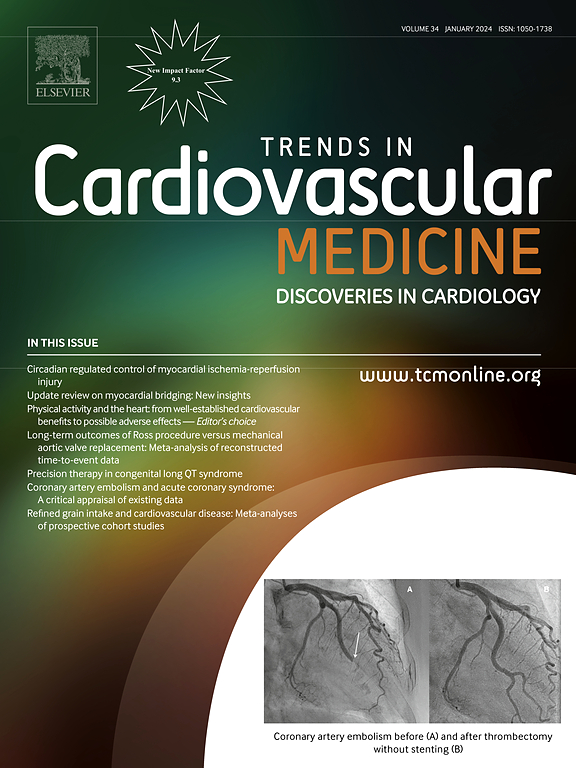Personalization of primary prevention: Exploring the role of coronary artery calcium and polygenic risk score in cardiovascular diseases
IF 9
2区 医学
Q1 CARDIAC & CARDIOVASCULAR SYSTEMS
引用次数: 0
Abstract
Personalized healthcare is becoming increasingly popular given the vast heterogeneity in disease manifestation between individuals. Many commonly encountered diseases within cardiology are multifactorial in nature and disease progression and response is often variable due to environmental and genetic factors influencing disease states. This makes accurate early identification and primary prevention difficult in certain populations, especially young patients with limited Atherosclerotic Cardiovascular Disease (ASCVD) risk factors. Newer strategies, such as coronary artery calcium (CAC) scans and polygenic risk scores (PRS), are being implemented to aid in the detection of subclinical disease and heritable risk, respectively. Data surrounding CAC scans have shown promising results in their ability to detect subclinical atherosclerosis and predict the risk of future coronary events, especially at the extremes; however, predictive variability exists among different patient populations, limiting the test's specificity. Furthermore, relying only on CAC scores and ASCVD risk scores may fail to identify a large group of patients needing primary prevention who lack subclinical disease and traditional risk factors, but harbor genetic variabilities strongly associated with certain cardiovascular diseases. PRS can overcome these limitations. These scores can be measured in individuals as early as birth to identify genetic variants placing them at elevated risk for developing cardiovascular disease, irrespective of their current cardiovascular health status. By applying PRS alongside CAC scores, previously overlooked patient populations can be identified and begin primary prevention strategies early to achieve optimal outcomes. In this review, we expand on the current knowledge surrounding CAC scores and PRS and highlight the future possibilities of these technologies for preventive cardiology.
初级预防的个性化:探索冠状动脉钙和多基因风险评分在心血管疾病中的作用。
由于个体之间的疾病表现存在巨大的异质性,个性化医疗正变得越来越流行。由于环境和遗传因素对疾病状态的影响,心脏病学中常见的许多疾病都具有多因素性质,疾病的进展和反应也往往各不相同。这使得某些人群,尤其是动脉粥样硬化性心血管疾病(ASCVD)危险因素有限的年轻患者,很难进行准确的早期识别和一级预防。冠状动脉钙化(CAC)扫描和多基因风险评分(PRS)等新策略正在实施中,以分别帮助检测亚临床疾病和遗传风险。有关 CAC 扫描的数据显示,其在检测亚临床动脉粥样硬化和预测未来冠心病事件风险(尤其是在极端情况下)的能力方面取得了可喜的成果;但是,不同患者群体之间存在预测差异,从而限制了该测试的特异性。此外,仅依靠 CAC 评分和 ASCVD 风险评分可能无法识别一大批需要进行一级预防的患者,这些患者缺乏亚临床疾病和传统风险因素,但却存在与某些心血管疾病密切相关的基因变异。PRS 可以克服这些局限性。这些分数可以在个体出生时就进行测量,以确定哪些基因变异会使其罹患心血管疾病的风险升高,而不论其目前的心血管健康状况如何。通过将 PRS 与 CAC 评分一起应用,可以确定以前被忽视的患者人群,并尽早开始一级预防策略,以达到最佳效果。在这篇综述中,我们扩展了目前有关 CAC 评分和 PRS 的知识,并强调了这些技术在预防性心脏病学方面的未来可能性。
本文章由计算机程序翻译,如有差异,请以英文原文为准。
求助全文
约1分钟内获得全文
求助全文
来源期刊

Trends in Cardiovascular Medicine
医学-心血管系统
CiteScore
18.70
自引率
2.20%
发文量
143
审稿时长
21 days
期刊介绍:
Trends in Cardiovascular Medicine delivers comprehensive, state-of-the-art reviews of scientific advancements in cardiovascular medicine, penned and scrutinized by internationally renowned experts. The articles provide authoritative insights into various topics, encompassing basic mechanisms, diagnosis, treatment, and prognosis of heart and blood vessel disorders, catering to clinicians and basic scientists alike. The journal covers a wide spectrum of cardiology, offering profound insights into aspects ranging from arrhythmias to vasculopathies.
 求助内容:
求助内容: 应助结果提醒方式:
应助结果提醒方式:


